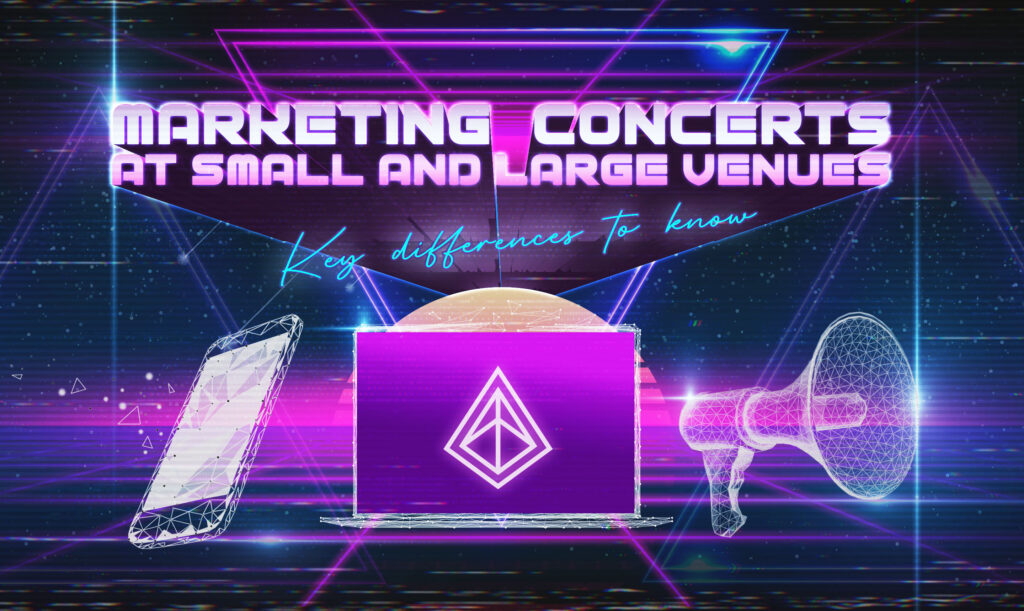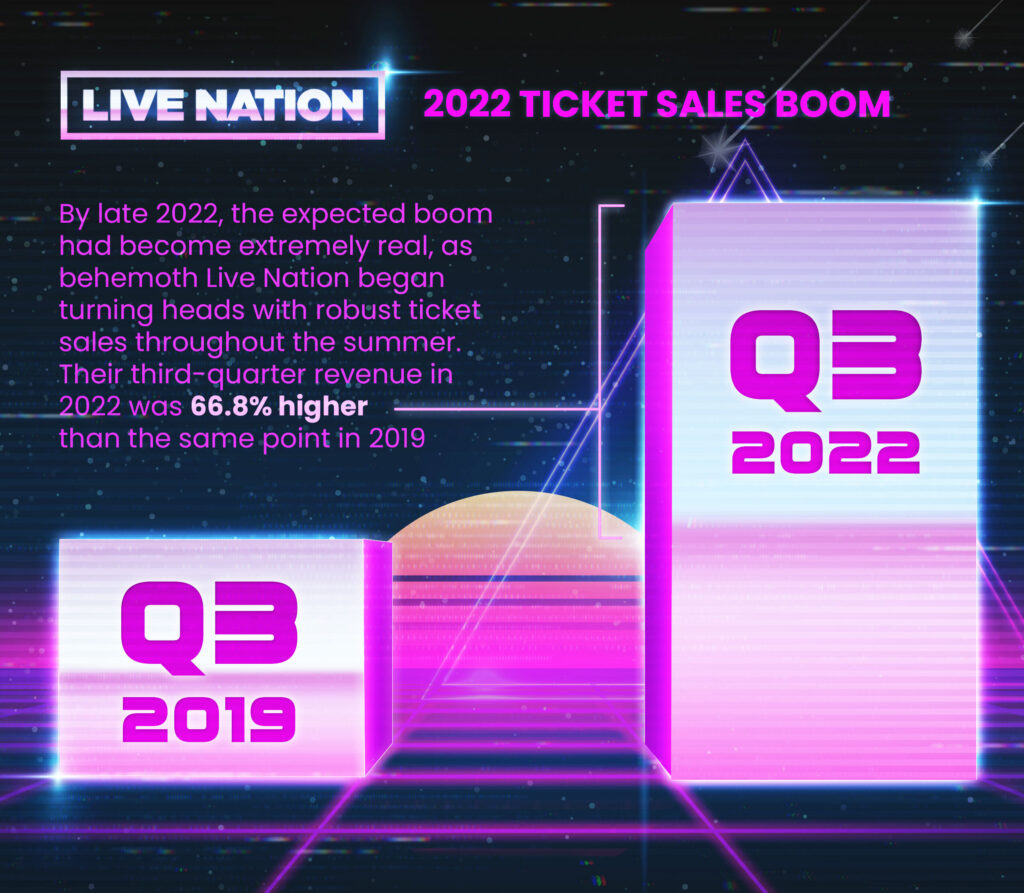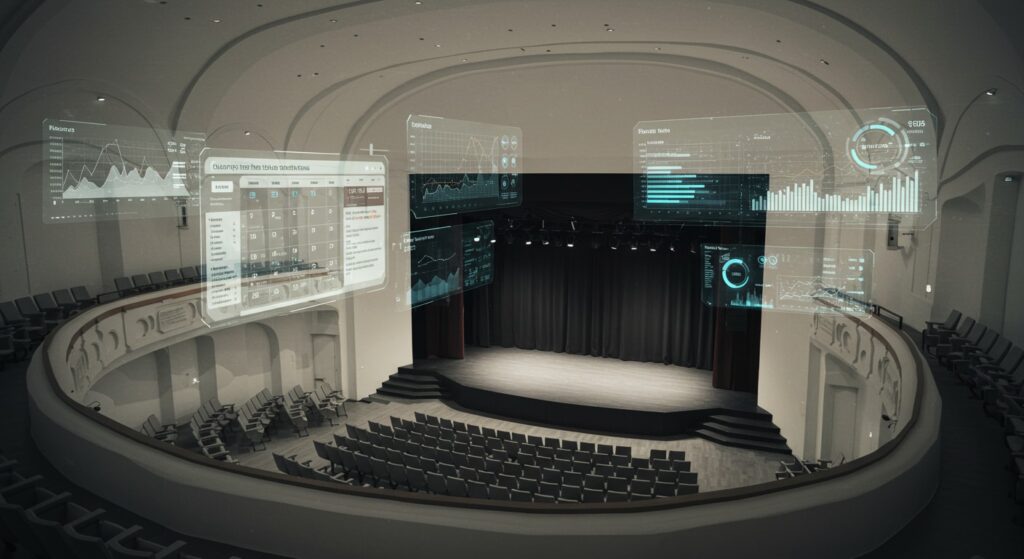
Marketing Concerts at Small and Large Venues: Key Differences To Know
The versatility of live music continues to be one of the hallmarks of the music industry. While the biggest events tend to get the most publicity, audiences can often feel the strength of live music at the most intimate of local venues, where they come to make a closer connection with their favorite artists. As live concerts have successfully reemerged, music venues must aim to ensure that the reignition of fan support translates into packed houses and eager calls for encores.
While the appetite for live music appears to be as strong as ever, creating a customized marketing plan to fit the scope of a venue has never been more critical. Venues must know their audience and where that audience’s attention lies to help decide which marketing methods, channels and platforms to use.
Although it can be overwhelming, given the number of marketing channels available, expanded options create a whirlwind of opportunities to reach a target audience. New digital tools and management platforms are also giving venues of all sizes an organizational boost, aiding efforts to create more efficient operations that can maximize marketing outreach.
Here’s how small and large venues are looking to shape their marketing efforts within the revitalized world of live music.
Riding the resurgence of live music
By late 2022, the expected boom had become extremely real, as behemoth Live Nation began turning heads with robust ticket sales throughout the summer. Their third-quarter revenue in 2022 was 66.8% higher than the same point in 2019, reflecting a surge in ticket revenue alongside a dash of inflation. While costs certainly rose throughout live music in 2022 – like nearly all industries – the crowds came back in a big way to breathe life back into the entire industry.

However, the reality is different for smaller venues and shows, which now face a more challenging path back after the tribulations of the pandemic. While larger operations are better positioned to absorb inflated costs and worker shortages, smaller venues have struggled to tap the rebound in the same way as their larger counterparts.
Independent operators have pointed to the sheer amount of work needed to handle demand, creating a stream of hurdles amid the ongoing recovery. This points to a music industry that has to be more efficient in marketing efforts, more creative in finding audiences, and more adept at ensuring shows meet the hype.
Backed by new strategies and an energized fan base, live music has a great opportunity to prove the naysayers wrong heading deeper into the post-Covid era. Despite some overly bleak forecasts for live music, there are brewing tailwinds that should improve the outlook for venues both big and small.
The easing of supply chain issues and exciting new outlets for reaching the most passionate fans (like augmented reality and virtual shows) may provide a boost that continues to spur venues on to greater success. The question becomes how well individual venues will be able to market their shows in order to flourish instead of merely surviving.
Understanding the reach of small and large music venues
In a world often defined by clicks, likes, and giant concerts, the small venue experience can almost seem quaint on a superficial level. From that lens, it’s no surprise that the smallest venues often have the most work to do to participate in the industry comeback. But venues can market their uniqueness as a feature and not a drawback, tapping into one of the most prominent trends in today’s live music industry: the desire for closer connections with artists.
RELATED: What to expect from the event promotion and concert industry in 2023
As concertgoers look for increased stage visibility and better overall experiences than before, it’s the smaller venues that often have the advantage. With the explosion of social media, fans have come to expect a level of personal connection that was difficult to impossible in previous eras. When marketing small venues, managers and promoters can lean directly into this fan expectation and showcase how their venue or show can offer the level of connection a fan seeks.
Another critical aspect for small venues to focus on from a marketing angle is the desire for fans to find the next breakout star. Large venues are—broadly speaking—frequented by seasoned bands and artists that have already built huge fanbases and achieved some level of commercial success. But at small venues, fans will come to see emerging artists and underappreciated bands whose brightest days are still ahead of them. They enjoy supporting them and telling others about their concert experience.
Savvy marketers can capitalize on this, promoting smaller-scale shows to get intimate with bands whose careers are just starting to take off. Venues that successfully promote under-the-radar talent can create loyalty among patrons who associate the venue with the excitement of discovery.
Expanding exposure at the most prominent venues
On the other side of live music, larger venues can maximize exposure and use scale to their advantage. In addition to marketing a big show as a can’t-miss social experience, these venues must begin to consider fans who can’t physically attend. By creating an exhilarating virtual experience, venues can extend the reach of a show even further and offer incentives for fans to encourage them not to miss the next big event. The best marketers can take the success of one sold-out show and invigorate demand for others down the road.
Scalability and tracking ticket sales in real-time
As we’ve seen with several major news stories about concert tickets, even the biggest shows can give way to some chaos as tickets go on sale. For small venues with a limited capacity, accurately anticipating the demand for tickets is an essential part of presale preparation, as everything from marketing to ticket prices will be impacted.
While smaller venue operators market the exclusivity of an event, it helps to have as smooth of a ticketing process as possible—for fans, the live music experience starts the moment they attempt to purchase tickets for the show. This is why having a ticket purchase option on a venue website is key to preventing cart abandonment. Likewise, being able to track ticket sales in real time has become a critical part of the process for venues of all sizes.
Some independent operations may use older ticketing systems, but their competition is likely moving on to real-time ticket updates to help ensure a high level of organization from the outset. Management platforms that use autonomous and cloud-based tools to track ticket sales can keep everyone on the team synced, allowing easy marketing adjustments on the fly.
Related: What to expect from concert and event promotion industry in 2023
For larger venues featuring some of the biggest acts in live music, managers and promoters are looking for fresh ways to market their shows to the most passionate fans. This means developments like expanding the VIP experience, adjusting costs for the most desirable seats, and in many cases offering AR (augmented reality) to take the in-person experience to the next level. The opportunity for expanded revenue can justify a more substantial marketing budget compared to many smaller venues that must be as mindful as ever of budgetary considerations.
Although the marketing will differ significantly from a small show to a large one, utilizing real-time ticket information is now an essential part of the concert process, regardless of scale.
Audience targeting that fits the size of the show
While audiences are becoming increasingly familiar with artists on a more personal level, the same is true of venue managers using these outlets to better understand who is coming to the shows. Social media has expanded audience reach but makes marketing concerts more complex. These social outlets are also powerful tools for finding a specific audience—a development especially useful for small and independent venues that want to know their audience and nurture relationships. Regarding more intimate, small-scale affairs, promoters can now target niche groups with lean marketing campaigns that fit budgetary limitations.
In addition, there are plenty of opportunities to get creative and customize a marketing plan without breaking the bank. While print marketing often comes at a high cost, digital marketing is cost-effective and flexible. High-performing organic social media channels like TikTok, Facebook Reels and Instagram Reels can be perfect additions for the right genre or artist; for others, simple text message chains or newsletters can provide a big reach at a minimal cost.
As small venues can create an efficient marketing campaign tailored to a somewhat narrow audience, larger venues have all the resources they need to go much bigger and broader. An aggressive marketing campaign that cuts across paid advertising on social media, CTV, billboards, radio and other channels can quickly appeal to the diverse audience that might fill a large auditorium, stadium, or festival ground. Smaller venues don’t always have the same capabilities, but they can manage a marketing campaign on a smaller scale.
The tech advances that touch the live music industry can be daunting, but there are now marketing and outreach tools for every type of show. In short, a venue’s marketing can be as creative or wide-reaching as necessary, providing plenty of flexibility for venue operators and promoters to find ticket buyers.
Embracing the customization of today’s live music scene
Following some of the most challenging years in the history of live music, venue operators and promoters now emerge into a changed world where knowing the audience has never been more critical. Larger venues with deeper pockets allow marketers to go bigger than ever before.
Smaller, local venues can create highly targeted social ads for local audiences, reach out to local Facebook groups or websites, find fans of similar bands, or engage in street team tactics like posting flyers in key places with high local foot traffic.
By fine-tuning marketing campaigns to fit the scale of a show and utilizing today’s technology to their advantage, promoters and venue operators can position themselves to take full advantage of the ongoing boom in live music. Exciting new frontiers for reaching specific audiences allow venues to use both traditional and emerging methods to form customized marketing campaigns within the confines of their budgets.
Whatever your venue or event’s goals, Prism offers cloud-based management tools that can help you customize a full booking and financial system that works for you. Contact us today to see what our platform, built by music professionals, can do to increase efficiency and give you the competitive edge you need to thrive.

Matt Ford is the founder and CEO of Prism.fm, an Austin-based software company revolutionizing live music event management. With a background in entrepreneurship and a degree from the University of Wisconsin-Madison School of Business, Ford combined his self-taught coding skills with firsthand experience as a concert promoter to address the inefficiencies he observed in the industry. In 2018, he launched Prism.fm, an all-in-one platform designed to streamline operations for venues, promoters, and agencies by replacing cumbersome spreadsheets with integrated tools for booking, financial tracking, and contract management. Under his leadership, Prism.fm has grown significantly, achieving $3 million in annual recurring revenue post-COVID and securing over $15 million in funding . Ford’s commitment to building user-centric solutions has positioned Prism.fm as a trusted partner for over 1,500 venues and promoters worldwide.



